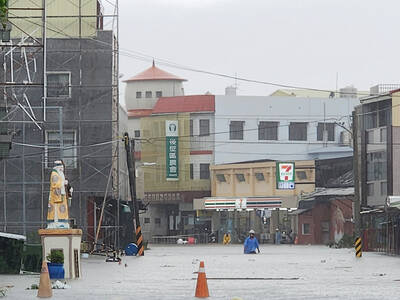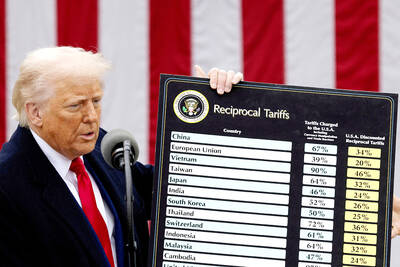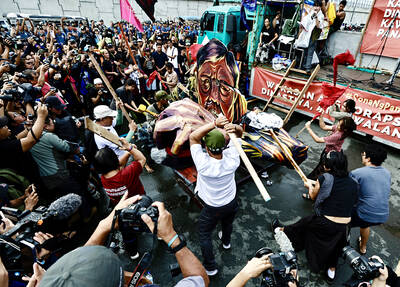Haute couture is all about dressing up — dressing way, way, up, in fact, in made-to-measure garments that cost as much as a new car. But Jean Paul Gaultier reversed the equation on Wednesday, sending out burlesque star Dita Von Teese, who peeled off layer after wildly expensive layer till she was stripped literally to the bone.
The campy strip show — which ended with Von Teese in a buff-colored bustier with sequin-covered applique bones mapping out her skeleton — was a fit finale to a fall-winter 2010-2011 collection largely about transparency and anatomy, with a dash of morbidness thrown in for good measure.
At Valentino, the garment’s anatomy — the bone-work that give the gowns their shape — took center stage, with translucent hoop skirts and an oblong birdcage made of tulle fitted over the bum-skimming mini-dresses.
Earlier in the week, Riccardo Tisci showed off the skill of the seamstresses at the house of Givenchy, delivering Mexican Day of the Dead-inspired lace and tulle bodysuits and gowns with appliques that mapped out the bones of the human body. In glimmering gold rhinestones and the finest Chantilly lace, his museum-quality concoctions were the world’s most expensive Halloween skeleton costumes.
On Aura Tout Vu’s fish-themed collection was meant for the thin slice on the Venn diagram where the very wealthy and very funny demographics overlap. After all, it takes a pretty good sense of humor to pull off an impeccable beige sheath dress with sleeves ending in stuffed fish-face hand puppets.
French veteran Franck Sorbier’s uplifting collection underscored the core values of couture — which is meant to be a celebration of creativity and technical savoir faire, but has increasingly become a media blitz used by luxury conglomerates for promoting aspirational secondary products like cosmetics, perfumes and sunglasses. Coming after big-budget mega-productions like Tuesday’s Chanel show, where models paraded beneath an enormous golden lion — in an homage to the founder’s astrological sign — Sorbier’s sincere and funny collection was a much-needed reminder of what couture should be about.
JEAN PAUL GAULTIER
The man who gave the world Madonna’s pointy bra went deeper in his exploration of the concept of underwear-as-outerwear with his anatomical collection of lean skirt suits and bustiers covered with rhinestone-encrusted femurs, tibias and ribs.
The porcelain-skinned burlesque star Dita Von Teese drove the audience wild with her mid-show strip tease, peeling off layer after layers of her black gown till she was wearing nothing but a bustier emblazoned with a twinkling applique skeleton.
“It was all about structure, about bringing the bones, the very foundation of what makes a garment, to the surface,” Gaultier told reporters in a post-show interview. “It’s about bones, but not in a ghost kind of way — unless we’re talking about the ghost of couture,” he joked.
Even the bride, who traditionally closes Paris’ made-to-measure couture collections, was wearing a trench coat — a Gaultier staple — in bone white mircofiber with a long tulle veil. And because this was Gaultier show — where a stiff dose of theatricality is de rigeur — the bride was playing her own wedding march — on a matching white violin.
RABIH KAYROUZ
Kayrouz flouted both convention and season, sending out barefoot models who, instead of careening down the runway in vertiginous heels, ambled barefoot over a catwalk covered in real grass wearing pleated silk tank-dresses for what was in theory a fall-winter show.
The audience of fashion editors, stylists and journalists — baking under the summer sun in courtyard — eyed Kayrouz’s fan-pleated silk dresses and airy, wide-legged trousers with undisguised envy. A knit tank-dress in chartreuse and a shirt-dress in bold teal looked particularly appealing to the melting crowd of fashion insiders.
Little green feathers, like a nascent layer of moss, emerged from the creases of the pleats that covered a putty-colored silk dress.
Belts in gold metal gave a hard edge to the gauzy knits and silks.
While other designers sent out more season-appropriate looks in leather with a sprinkling of fur, Kayrouz said he was seeking a middle route between couture’s ultra-exclusive looks made-to-measure for a handful of fabulously wealthy women and the off-the-rack designs most of us morals are condemned to wearing.
“Haute couture as we know it is almost something passe,” he said. “There’s no time for that. Now clients are very demanding and they want those well-designed, well-cut pieces in great materials, but they want them off the rack.”
VALENTINO
Valentino’s new design duo, who’ve been charged with the difficult task of rejuvenating the label’s aging customer base, had something for everyone — or, depending on how you look at it, nothing for anyone — with a collection that paired matronly chiffon blouses with the miniest of mini-dresses.
Designers Pier Paolo Piccioli and Maria Grazia Chiuri, who were promoted out of Valentino’s lucrative accessories division after the designer who briefly replaced founder Valentino Garavani was dismissed, have demonstrated their predilection for creeping hemlines in seasons past — to mixed reviews.
They gave it another shot, sending out pretty little bustier dresses that grazed the tops of the models’ gazelle thighs.
Sometimes the dresses, in black, beige, sea green and baby pink, were worn alone, sometimes layered over long-sleeved chiffon blouses that felt like they were channeling a 1970s schoolmarm.
It was a pretty collection, overall, but one that might prove a hard sell to the over-17 set, whose thighs no longer resemble those of a deer.

Rainfall is expected to become more widespread and persistent across central and southern Taiwan over the next few days, with the effects of the weather patterns becoming most prominent between last night and tomorrow, the Central Weather Administration (CWA) said yesterday. Independent meteorologist Daniel Wu (吳德榮) said that based on the latest forecast models of the combination of a low-pressure system and southwesterly winds, rainfall and flooding are expected to continue in central and southern Taiwan from today to Sunday. The CWA also warned of flash floods, thunder and lightning, and strong gusts in these areas, as well as landslides and fallen

WAITING GAME: The US has so far only offered a ‘best rate tariff,’ which officials assume is about 15 percent, the same as Japan, a person familiar with the matter said Taiwan and the US have completed “technical consultations” regarding tariffs and a finalized rate is expected to be released soon, Executive Yuan spokeswoman Michelle Lee (李慧芝) told a news conference yesterday, as a 90-day pause on US President Donald Trump’s “reciprocal” tariffs is set to expire today. The two countries have reached a “certain degree of consensus” on issues such as tariffs, nontariff trade barriers, trade facilitation, supply chain resilience and economic security, Lee said. They also discussed opportunities for cooperation, investment and procurement, she said. A joint statement is still being negotiated and would be released once the US government has made

SOUTH CHINA SEA? The Philippine president spoke of adding more classrooms and power plants, while skipping tensions with China over disputed areas Philippine President Ferdinand Marcos Jr yesterday blasted “useless and crumbling” flood control projects in a state of the nation address that focused on domestic issues after a months-long feud with his vice president. Addressing a joint session of congress after days of rain that left at least 31 dead, Marcos repeated his recent warning that the nation faced a climate change-driven “new normal,” while pledging to investigate publicly funded projects that had failed. “Let’s not pretend, the people know that these projects can breed corruption. Kickbacks ... for the boys,” he said, citing houses that were “swept away” by the floods. “Someone has

‘CRUDE’: The potential countermeasure is in response to South Africa renaming Taiwan’s representative offices and the insistence that it move out of Pretoria Taiwan is considering banning exports of semiconductors to South Africa after the latter unilaterally downgraded and changed the names of Taiwan’s two representative offices, the Ministry of Foreign Affairs (MOFA) said yesterday. On Monday last week, the South African Department of International Relations and Cooperation unilaterally released a statement saying that, as of April 1, the Taipei Liaison Offices in Pretoria and Cape Town had been renamed the “Taipei Commercial Office in Johannesburg” and the “Taipei Commercial Office in Cape Town.” Citing UN General Assembly Resolution 2758, it said that South Africa “recognizes the People’s Republic of China (PRC) as the sole